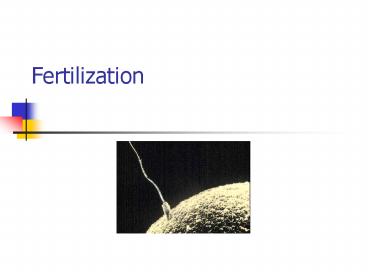Fertilization - PowerPoint PPT Presentation
Title:
Fertilization
Description:
Fertilization Fertilization: the fusion of the sperm cell nucleus with the egg cell nucleus to produce a zygote (fertilized egg) Fertilization: External Occurs ... – PowerPoint PPT presentation
Number of Views:471
Avg rating:3.0/5.0
Title: Fertilization
1
Fertilization
2
Fertilization
- the fusion of the sperm cell nucleus with the
egg cell nucleus to produce a zygote (fertilized
egg)
3
Fertilization
- External
- Occurs outside of the body of the female
- Increased number of eggs produced to insure the
survival of the species - Ex) fish and amphibians
4
Fertilization
- Internal
- Occurs inside the body of the female
- Fewer number of eggs are produced
- Increased parental care insures species survival
- Ex) mammals, reptiles, birds
5
Fertilization
- fertilization in mammals occurs in the oviduct
- The ova is viable for approximately 24 hours
after ovulation
6
(No Transcript)
7
Implantation
- After approximately a week, the developing embryo
is implanted into the uterus - Embryo conception to 8 weeks
8
Embryonic Development
9
(No Transcript)
10
Embryo
- a multicellular organism in the early stages of
development - 2 four cell stage embryos
- Eight cell stage embryo
11
Embryo
- The beginning developmental processes are always
the same in all animals - 1) cleavage
- 2) growth
- 3) differentiation
12
Embryo
- after fertilization the diploid ZYGOTE undergoes
cleavage divisions in the oviduct
13
Cleavage
- the first series of cell divisions by mitosis
after fertilization - Cell division is rapid, new cells do not take
time for the growth phase G1 - cell growth does not occur so cells decrease in
size with each cleavage division
14
Cleavage divisions
15
- Morula forms (solid ball of cells)
- Blastula forms (hollow ball of cells)
- Cells begin to grow before dividing
16
(No Transcript)
17
Differentation
- Gastrulation one side of the blastula
invaginates (indents) forming a gastrula - Three cell layers form
18
Differentation
19
Differentiation
- The changing of unspecialized embryonic cells
into the specialized cells, tissues and organs of
a multicellular animal
20
Germ Layers
- Ectoderm Outer layer
- Nervous system including brain, spinal cord and
nerves - Lining of the mouth, nostrils, and anus
- Epidermis of skin, sweat glands, hair, nails
21
Germ Layers
- Mesoderm Middle Layer
- Bones and muscles
- Blood and blood vessels
- Reproductive and excretory systems
- Inner layer (dermis) of skin
22
Germ Layers
- Endoderm Inner Layer
- Lining of digestive tract
- Lining of trachea, bronchi, and lungs
- Liver, pancreas
- Thyroid, parathyroid, thymus, urinary bladder
23
Placenta
- organ that forms from the embryo and the uterus
24
Placenta
- contains blood vessels from the mother and the
developing baby
25
Placenta
- Oxygen nutrients diffuse from the mothers
blood vessels into the babys blood vessels - Wastes diffuse from the babys blood vessels into
the mothers blood vessels
26
Umbilical Cord
- two arteries and a vein Connects the fetus to the
placenta
27
Amniotic Sac
- Contains fluid (amniotic fluid) that protects
fetus by giving it a stable environment and
absorbing shock
28
- By the end of the 8th week of pregnancy the
embryo is called a fetus and all of the major
structures are present
29
Later Stages of Fetal Development
30
Human gestation
- the period between fertilization and birth
- approximately 38-40 weeks
31
Teratogens
- Substances that may harm the developing fetus and
result in the formation of birth defects
32
Teratogens include
- Alcohol, certain drugs/medications, infections,
and certain chemicals
33
(No Transcript)
34
Fetal Alcohol Syndrome
- Can result in mental retardation / learning
disability - Facial Features
- Epicanthal folds
- Small, widely spaced eyes
- Flat midface
- Short, upturned nose
- Smooth, wide philtrum
- Thin upper lip
- Underdeveloped jaw
35
Cleft Lip / Palate
- maternal alcohol consumption and maternal smoking
during the early stages of pregnancy have been
shown to increase the risk of developing
orofacial clefts - http//www.hopeforkids.com/body_cleft_lip5B15D.h
tml
36
How do twins form???
37
Monozygotic Twins(Identical Twins)
- One egg is fertilized by one sperm
- Embryo splits into two during the early stages of
development - Have identical genes and must be of the same sex
- (Incidence about 3 in every 1000 births)
38
Dizygotic Twins(Fraternal Twins)
- Two eggs are ovulated and each is fertilized by a
sperm cell - No more genetically similar than any other
sibling in the family (can be same/different
sexes) - Maternal age, use of assisted reproductive
technologies are factors - Incidence (6.7/1000 births in Japan to 40/1000
births in Nigeria)































